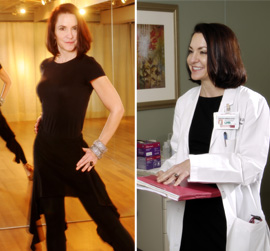In Step with Debora Kimberlin, M.D.
By Lisa C. Bailey
 |
Dancer, doctor: After a full week treating patients at UAB, Debora Kimberlin often drives to Nashville for a weekend of dance lessons and competitions. |
By day, Debora Kimberlin, M.D., helps high-risk obstetric patients at UAB navigate the difficult steps of challenging pregnancies. Most nights and weekends, she can be found moving smoothly through the steps of very different challenges—such as waltzes, fox-trots, and tangos.
Kimberlin says she fell in love with ballroom dancing the moment she tried it. In fact, she entered her first competition just six weeks after her first lesson. “I’ll never forget going to that first competition and seeing the beauty of the sport,” she says. “I was hooked.”
UAB Magazine: Do you think it’s important to have a creative outlet, particularly with your type of work? Do medicine and dance complement each other?
Kimberlin: I think being a physician helps with dancing because both require patience and dedication. You can spend years working on some of the same very basic steps, and even the professionals continue to work on these basic steps to improve their technique.
UAB Magazine: What’s your favorite style of dance?
Kimberlin: I compete in both American rhythm and American smooth. I love the music and the elaborate gowns. Most people probably prefer the American rhythm, but right now my favorite is the smooth. American smooth includes four dances—the waltz, fox-trot, tango, and Viennese waltz. The cha-cha, rumba, East Coast swing, mambo, and bolero are the five American rhythm dances.
Watch Kimberlin dance in the Nashville Starz competition—an event she won—in this video slideshow (article continues below slideshow)
UAB Magazine: How many competitions have you been in?
Kimberlin: I don’t know exactly. A lot! I have a very busy competition schedule for the fall. I competed in Nashville in July, in Cleveland in September, and in Atlanta in October. In November I danced at the Ohio Star Ball, which is where the PBS special The American Ballroom Dance Challenge is filmed each year. It is an enormous competition—one of the largest in the world—and I was particularly excited to compete there. In December, I will compete in Las Vegas.
UAB Magazine: What would be a typical week for you?
Kimberlin: I work full-time in the Division of Maternal-Fetal Medicine and Reproductive Genetics, and in addition, have dance lessons two or three days per week. Each lesson is one hour long, and I generally take several lessons at a time. I train at Dance World in Nashville, Tennessee. Oftentimes, I drive to Nashville on Friday afternoon after I finish my ultrasound clinic. I usually dance three hours Friday night and five hours on Saturday. I drive back here Saturday evening.
Dance World is one of the top studios in the country; a number of U.S. champions teach there, and they get some of the top coaches from around the world to work with us. I feel so lucky to be able to dance there. I practice at home most days as well. I have a dance studio in my basement now with a television monitor for viewing instructional videos and video clips from my lessons of the steps or figures that I need to practice. I have even redone my house to accommodate this hobby.
UAB Magazine: What do you think about all the dance reality shows that are popular now?
Kimberlin: Before I started dancing with my current instructors, I danced very briefly with Fabian Sanchez, who owns the Fred Astaire Dance Studio in Hoover. Fabian was one of the professional dancers on Dancing with the Stars in its sixth season. I think that show has done some great things for ballroom dancing; it certainly increased the visibility and public awareness of the sport.
On the flip side, people who watch those fancy routines don’t realize that until you get to the highest amateur level or to the professional level, most routines don’t have all of those tricks. I’m always somewhat fearful that someone who comes to watch me dance will be disappointed because my routines are not as flashy as those on television.
UAB Magazine: What’s the biggest challenge of starting a hobby like this after establishing a career?
Kimberlin: When you’ve reached a certain level of accomplishment in your career, starting over as a beginner with a difficult hobby can be frustrating and intimidating, but it’s a great life lesson. I try not to be too hard on myself and to enjoy the process; the most important thing to remember is that we should always continue to learn and push ourselves to step out of our comfort zones.
More Information
Learn more about Women and Infant Services at UAB